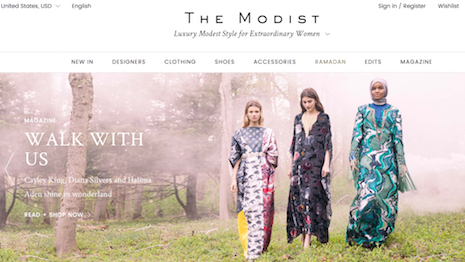 Image courtesy of The Modist, an online retailer geared toward Middle Eastern and modest women
Image courtesy of The Modist, an online retailer geared toward Middle Eastern and modest women
Lagging luxury ecommerce in the Middle East has prevented the market from reaching its full potential, according to a new white paper by The Chalhoub Group. The Chalhoub Group’s “Luxury in the GCC: Age of Digitalization” white paper examines the six countries within the Gulf Cooperation Council and how luxury in the market has been affected by the digital revolution. For more than 50 years, The Chalhoub Group has worked with brand partners to establish their businesses in the Middle Eastern market, which offers clients a deep understanding of the region and consumer behavior.
“Internet is instrumental in transforming GCC luxury consumers who now are very aware of labels, prices, trends and products, and can find almost any item on the Web," said Anthony Chalhoub, co-CEO at The Chalhoub Group, Dubai, United Arab Emirates.
"Faced with this level of volatility and exigence," he said, "We all have a lot to do, from adapting our Web sites so that they are user-friendly and accessible, to training our teams to be fully involved in the omnichannel, as the store and the digital properties now must complement one another – all the while protecting the brand’s DNA.
"It’s a learning curve, but in one way or another, we are all moving forward in that direction.”
The GCC includes Bahrain, Kuwait, Oman, Qatar, Saudi Arabia and the UAE. The Chalhoub Group partnered with British luxury brand alliance Walpole on the white paper. Connected to the GCC The Middle East has seen three decades of rapid and strong growth in markets such as Qatar, Kuwait and the UAE. Alongside this growth, digital and mobile innovations have disrupted and transformed the way in which business in the region, and the world, is conducted. While this is not true of all sectors, luxury in the Middle East has been slow to embrace today’s available technology. Noting this trend, The Chalhoub Group’s fifth white paper, Luxury in the GCC: Age of Digitalization, is dedicated to the ways in which technological innovations have caused a shift in consumption habits within the Middle East. Per its report, The Chalhoub Group found that ecommerce penetration is lackluster in the Middle East, a lost opportunity for luxury brand marketers. Currently, ecommerce makes up only 2.6 percent of total retail sales in the Middle East, compared to 7 percent globally in 2015. In the next four years, GCC consumers are forecasted to contribute $1.5 billion to the high-end market from ecommerce purchases alone. The Modist launched in March is a high-end online marketplace selling modest-style clothing (see story)
Youth culture in the Middle East has also transformed the luxury market in the region. More than half of the GCC’s population is under 30 and these consumers are informed, well-educated, tech-savvy and most importantly, digitally connected (see story).
Digital connectedness has been furthered by some of the highest Internet, smartphone and social media use in the world. For market success, luxury brands must ensure they have a continued online dialogue with Middle Eastern consumers.
In today’s world, power has gravitated from the brands to the hands of the consumer.
This has resulted in a consumer culture that craves experience and personalized marketing, as well as an omnichannel path to purchase. Middle Eastern consumers, as with their global peers, also desire to be included in the online conversation.
The power of influencers, such as millennial and Gen Z fashion bloggers and Insta-famous models, is seen to be increasing. Similar to elsewhere around the world, the market would much rather take product and style advice from a peer than directly from a luxury brand.
Omnichannel for all
To prepare for the future, The Chalhoub Group suggests actively establishing digital platforms that are localized for the GCC market, a step that many brands have already actively undertaken.
The Chalhoub Group recommends that luxury brands first figure out the digital paradox. For brands in the luxury sector it is incredibly important to protect the fundamentals of the industry while in a digital setting.
Being present is not enough, though. Luxury must establish long-term, comprehensive and authentic digital strategies to speak to the Middle Eastern consumer and to maintain relevancy in a crowded space.
A necessary strategy is omnichannel and cross-platform ecommerce capabilities.
For new brands entering the market, unique experiences are essential to garnering the attention of the modern Middle Eastern consumer.
Italian label Versace, for example, marked the opening of its Dubai resort in couture fashion.
To celebrate the grand reveal of Palazzo Versace Dubai, the brand brought its couture collection to the city for the first time, giving local clientele the opportunity to view the collection and meet with its atelier team. As a fast growing market for hard luxury goods, creating this lifestyle brand extension in the Middle East may benefit Versace (see story).
The Modist launched in March is a high-end online marketplace selling modest-style clothing (see story)
Youth culture in the Middle East has also transformed the luxury market in the region. More than half of the GCC’s population is under 30 and these consumers are informed, well-educated, tech-savvy and most importantly, digitally connected (see story).
Digital connectedness has been furthered by some of the highest Internet, smartphone and social media use in the world. For market success, luxury brands must ensure they have a continued online dialogue with Middle Eastern consumers.
In today’s world, power has gravitated from the brands to the hands of the consumer.
This has resulted in a consumer culture that craves experience and personalized marketing, as well as an omnichannel path to purchase. Middle Eastern consumers, as with their global peers, also desire to be included in the online conversation.
The power of influencers, such as millennial and Gen Z fashion bloggers and Insta-famous models, is seen to be increasing. Similar to elsewhere around the world, the market would much rather take product and style advice from a peer than directly from a luxury brand.
Omnichannel for all
To prepare for the future, The Chalhoub Group suggests actively establishing digital platforms that are localized for the GCC market, a step that many brands have already actively undertaken.
The Chalhoub Group recommends that luxury brands first figure out the digital paradox. For brands in the luxury sector it is incredibly important to protect the fundamentals of the industry while in a digital setting.
Being present is not enough, though. Luxury must establish long-term, comprehensive and authentic digital strategies to speak to the Middle Eastern consumer and to maintain relevancy in a crowded space.
A necessary strategy is omnichannel and cross-platform ecommerce capabilities.
For new brands entering the market, unique experiences are essential to garnering the attention of the modern Middle Eastern consumer.
Italian label Versace, for example, marked the opening of its Dubai resort in couture fashion.
To celebrate the grand reveal of Palazzo Versace Dubai, the brand brought its couture collection to the city for the first time, giving local clientele the opportunity to view the collection and meet with its atelier team. As a fast growing market for hard luxury goods, creating this lifestyle brand extension in the Middle East may benefit Versace (see story).
"Our strategy is to get a better knowledge of our audience and initiate a real dialogue with them, both physically and digitally – because the future of luxury cannot be one of the two: consumers’ experience must seamlessly connect offline and online," said Patrick Chalhoub, co-CEO Chalhoub Group, Dubai, UAE.
"It’s a major transformation for the retail scene, which will have to restructure itself accordingly," he said. "Those who want to endure have to get ready, and get ready now or risk being left out.”
